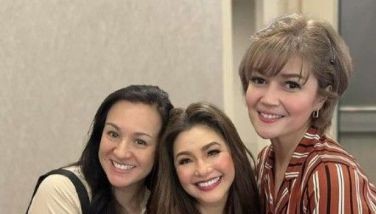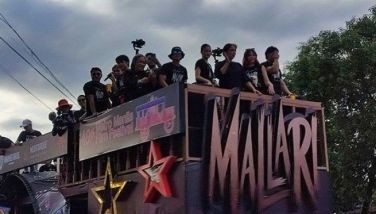Literary treasures unveiled painlessly
After a piece on pre-colonial art from Paris, we had promised a story on what Filipino educators are doing to interest students in the study of Filipino culture sometime next week. However, the impact of our Bulul story on students was such that we are moving forward our report from the Philippines.
Back in March, we watched the last play of Tanghalang Pilipino’s 26th season, a traditional Bicolano epic put to song called Ibalong. The play, with its countless fantastic creatures like diwatas and deities, was stimulating. It was magical. We wanted more.
Last week at FEU FERN College in Q.C., we stopped at the crowded campus bookstore, seeking refuge amongst the high-stacked shelves when a bright yellow book caught our eye: Literary Treasures of the Philippines by Edna Aquino. Quickly fingering through the pages, we were pleased to find a textbook that was interesting and easy reading apart from giving necessary information. The thick 330-page book costing P360 is remarkably easy to get into and equally remarkably difficult to put down. Organized into chapters according to Philippine regions, Chapter 1 begins with Ilocos, the Cordilleras, on to Central Luzon, the Visayas and Mindanao.
Each chapter is a journey in itself providing excellent overview of the islands pre-Spanish and pre-Muslim. In descriptive educative fashion, the author introduces the region’s brief history, explains how the people subsisted through the centuries and offers fascinating insight on how they viewed the world. For example, several tribes in our mountainous north divided the cosmos into five “planes.†Beyond the heaven, earth and underworld, there exists an equally important upstream and downstream world. Several southern tribes share the belief that heaven is made up of seven or nine layers, evidence of a distant past with the Hindu-animist cultures of Sri Vijaya and Majapahit empires that thrived more than a millennium ago.
The Aetas that occupied many areas in Luzon are known for their dark skin and kinky hair, and also for their resistance to change. They are possibly the oldest tribe we have today, dating back to pre-historic times. But the tribe with the most interesting cosmological set-up comes from the Bilaan living in forested areas between Davao and Cotabato City who believe that heaven exists beneath the earth, where “there is no room to grow rice and the chasing of deer is forbidden.â€
Examples of regional literature proliferate throughout the textbook with most translated into English. The literary forms are as varied as our people. From simple riddles, (it wears a crown but isn’t a queen; it has scales but isn’t a fish — answer pineapple), the works expand into proverbs, moral teaching fables, all of which lend insight into the cultures and mores that flourished around our country. Literary Treasures further chronicles longer pieces, oral traditions captured on paper, heroic epics that entail love affairs, animals with extraordinary powers, battles with gods, anitos and diwata, and heroic acts that establish a tribe’s belief in system and social institutions. Included among these is the Bicolano Ibalon we saw staged three months ago.
What we found most interesting is the number of creation myths throughout the book. The simplest comes from the Kankanai of Benguet and Ilocos Sur which states that man’s first action was to laugh — a far cry from the lonely Adam and his guilt-ridden Eve who just had to share that apple. The stark differences reveal a lot about our world view.
Among our favorites is the Mansaka (Davao and Compostela Valley) of Kimod who goes through a test assisted by insects and animals to prove he is worthy of the woman he wants as his wife. His diwata brother-in-law Timasa is the juror, and after Kimod succeeds at several tests, Timasa and Kimod celebrate with a drinking session before allowing him to take back his wife.
As a casual read, Literary Treasures of the Philippines takes us on a journey introducing to us a Philippines that many of us are clueless about. And the beauty about this book is that it is just a textbook, approved by CHED, scratching only the surface of mythologies and legends that exist in our provinces. With Aquino’s Literary Treasures of the Philippines, many students have been provided the resources needed to dive deeper into the many fabled lands of our pre-colonial ancestors.
(Send your comments to [email protected].)
- Latest
- Trending





























